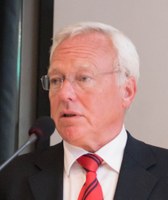Leaving the books behind
Author biography
30 aprile 2021
Chris Pickles, a graduate from the University of Lancaster in the United Kingdom, worked for Burroughs from its office in Preston, Lancashire, UK as his first real job after graduating. He worked as a salesman and software developer, creating programs for Burroughs computers, training people how to use them and providing customer support. He is the owner of the website http://picklesnet.com/, where he collects his and some of his colleagues’ memories on their time spent with Burroughs and on the technology that was used, complemented with historical photos.
The history of Burroughs
The primary claim to fame of Burroughs was its invention of the commercial adding machine in 1886. The basic concept of mechanisms that could add and subtract were at the heart of the corporation’s business globally for the next 80 years. In order to be able to audit the calculations made on the machines, their ability to print a record of each entry and any totals on paper was fundamental, as no other practical display technology existed at the time. Adding machines supported general office business practices and were the standard equipment used in accounting – also called “bookkeeping”. Financial records were generally kept on pages in books, called “ledgers”. Adding machines allowed users to add up columns of numbers quickly and to check and double-check totals. At a time when all information was stored on paper, it was vital for the adding machine to be able to print. Adding machines were as important a tool in business offices as the typewriter.
This requirement to be able to print is key to the next stage of development of Burroughs. Several principles are associated with this:
- replacing each paper page of a ledger with a card – a “ledger card”
- making the carriage and platen of the adding machine wider so that it could print across a wide card
- making the adding machine capable of adding up separate totals of multiple columns of numbers dependent on the position of the carriage.
These extra capabilities enabled the adding machine not only to add up numbers but to act as an accounting machine, or “bookkeeping machine”. The classic Burroughs accounting machine was the Burroughs Sensimatic. The use of ledger cards as a medium for information storage was behind the design and development of accounting machines and early office computers right through to the late 1970s, from the largest organisation to the smallest. (https://www.youtube.com/watch?v=OsCMB-FKjRc)
Developments in electronics – valves and, later, transistors – enabled more sophistication to be built into mechanical accounting machines and to extend their capabilities. In the 1950s the Burroughs Sensitronic accounting machine could read data from a magnetic stripe bound into a ledger card. This is an early example of the electronic storage of digital data. This “hybrid technology” – a mix of mechanical engineering and electronic engineering – enabled some of the first moves into modern computing, though in many ways it had the advantages of both technologies as well as the disadvantages of both technologies.
Burroughs was one of the earliest companies to move into the manufacture of computers, and quickly became the second largest computer manufacturer in the world, after IBM. Initially computers were hugely expensive and only used by the very largest organisations, but by the late 1960s the reducing cost of computers allowed them to be accessible to smaller organisations. Ledger cards were still fundamental to everyday business processes for smaller organisations and office computers targeted at this sector still used ledger cards. The Burroughs Series L/TC range of office computers is the classic example of this. These computers were not only used by commercial businesses: they were also installed in banks and in bank branches around the world to support local bank account management for clients as well as the transmission of data to the mainframe computers in the headquarters of banks.
As computers continued to reduce in cost and increase in their capabilities they gradually moved downmarket to be used by smaller organisations. The use of ledger cards to store data began to be replaced by digital data storage. The most expensive component of a computer, and therefore a resource that all computer operations aimed to optimize, was the main memory (RAM – Random Access Memory) linked to the processor. Burroughs experimented with disks to develop “virtual memory” – the use of high-speed disk storage to extend the capacity of the computer’s RAM at lower cost. Virtual Memory is still a vital core capability of today’s operating systems, including Microsoft Windows.
The 1960s and early 1970s brought the change-over in technology from mechanical to electronic. For smaller organizations – the majority of each country’s organisations - the late 1970s brought the change-over from data storage on paper and cards to data storage on disks.
In the 1970s, as well as its mainframe computers and medium systems, Burroughs developed a range of small office computers – the B700 series. As well as helping it to earn more revenue, it also helped Burroughs to understand better the technology, business and support needs of smaller organisations that were being introduced to computing for the first time. The company learned about the importance of package application software whose operation could be parameter-driven so that it could adapt and be flexible to meet the needs of different types of user-organisation. At the same time package application software could be offered at a lower cost than custom-built application software. Burroughs learned that application software was not something to be given away free, as before, in order to sell hardware: in the future, more revenue would be gained from the sale of application software than from hardware .
Its first small computer system that brought together all of this learning in the late 1970s was the Burroughs B80. Though it did not use ledger cards at all, like any system in a time of major technology change the B80 was a collection of old and new technology, and notably its use of disk drives was inherited from the previous generation of computers. It was the first Burroughs small computer to use “floppy disks” with a 1 megabyte capacity instead of 2.2MB disk cartridges – though 1MB disks had too little capacity to be really useful. However, the next key step was made with the introduction of the Burroughs B90 with its larger-capacity inbuilt 3MB floppy disk drives.
The development of the Burroughs B90 was happening at the same time that IBM was developing its “Personal Computer” (PC). The first IBM PC was a small computer that could be used for business applications and as a terminal for mainframe computers, as compared to the desktop computers such as Apple IIs, Commodore PETs and Tandy TRS-80s that were attracting computer hobbyists. But the IBM Personal Computer was the game-changer for the computer industry, and in particular for the market for smaller computers. Burroughs and the other four major computer manufacturers (Sperry Univac, NCR, Control Data and Honeywell) that competed against IBM were all caught without a product that could compete against and beat the IBM. They all reacted by buying the same small computers from a small US computer company called Convergent Technologies, re-badging them and competing against each other. Within a handful of years Burroughs had fallen from its place as No.2 to IBM (a place taken by DEC – Digital Equipment Corporation), merged with Sperry Univac to become Unisys, and withdrew from hardware manufacturing almost totally. A hundred years after it was founded, Burroughs was no more.
The Burroughs B90
In Padua museum there is a Burroughs B90 minicomputer, one of the few in the world that is on exhibition. When it was made, large mainframe computers had been in existence for over 20 years, but they were comparatively few in number due to their enormous cost and they were very large. Everything about mainframe computers was expensive. For example, in the late 1970s, when the B90, first appeared a laser printer for a mainframe computer that could print 12 pages per minute would be as large as a truck and cost around €250,000: today it is a small box that may cost €100. The Personal Computer had not yet been invented. The move away from traditional paper-based bookkeeping and ledger cards was only just beginning for the average office. The average office worker had never seen a computer except in science fiction films.
Earlier small Burroughs computers had been designed as communication devices – terminals that could talk to mainframe computers. Burroughs claimed that there were more Burroughs terminals connected to IBM computers than there were IBM terminals connected to IBM computers. By taking the data communications components out of these computers, Burroughs was able to offer a lower-cost small computer for smaller businesses – but still mainly using paper and ledger cards for data storage. Taking the big step away from paper and cards and into a purely-digital world required serious changes in hardware, application software and storage technology.
An outstanding and truly innovative feature of the Burroughs B90 was the introduction of a floppy disk that could store 3MB of data. While other manufacturers, including Burroughs itself, had all launched system with 1MB floppy disk drives, the B90 had three times the capacity per disk. This meant that rather than having to buy a large and more-expensive disk drive cabinet that could house 2 x 2.2MB disk cartridges, a B90 could deliver twin inbuilt 3MB disk drives. Having more storage capacity at less cost and needing less space made the Burroughs B90 stand out from its competition.
Burroughs had also long understood the importance of application software. While the price of hardware with the same capabilities was dropping over time, the price of application software was going up. Burroughs had made significant investment in the development of application software packages, for general-purpose accounting as well as for specialized areas of business such as contracting, manufacturing, production control, etc. The B90 benefited from being the third generation of Burroughs office computers that could use its “Business Management System” suite of tried and tested application software. Its operating system CMS (Computer Management System) had been developed across its whole range of computers.
When the B90 was launched, there was nowhere near today’s level of computer understanding or standardization. Operating systems were different from one manufacturer to another and from one computer model to another. Though the B90 would be operated by someone who had special training, the fact that CMS was the operating system for multiple models of Burroughs computers meant that operators could easily operate multiple models and sizes of systems.
The Burroughs B90 was not just a re-working and re-badging of old technology, and its 3MB floppy disk drive was a prime example of this. Storing so much data on a small storage medium, where both the disk and the disk drive would be impacted by changes in operating temperature, was a true challenge. To address this real-world problem, the 3MB disk drive would automatically recalibrate itself periodically throughout the day to allow for temperature changes.
Other computer manufacturers that considered that they made “real computers” would require their computers to have operators who understood great detail about the physical operation of the computer. For example, an operator would not just copy a file from one disk to another with a simple instruction, as we would do today with a modern computer. The operator would need to know on what physical track and in which physical sector of a disk a file started and in which track and sector the file ended. The operator would also need to know for the disk that was being copied to the track and sector that the file should be copied to and which tracks and sectors it should occupy. If the operator got any of that information wrong, the copy operation went wrong and valuable data either got lost or over-written. Burroughs CMS used a simple “Copy” function that took care of all of that automatically. Today we understand that the data on disks can get split up and fragmented, which can slow down the operation of the computer: to solve that problem, we use a “DEFRAG” command, and the disk gets reorganised automatically. Burroughs CMS used a simple “SQASH” command that achieved exactly the same result – forty years ago.
Even tiny details matters on the Burroughs B90. A user would spend much of their day typing numbers into the system. If you look at the numeric keypad of the B90, there is a tiny dimple on the 5 key. That allowed the operator to feel where their hand was, and therefore where each of the numeric keys were, so that they could enter data without having to look at the keypad. The overall keyboard layout was almost identical to its earlier Series L/TC office systems, allowing users to upgrade easily and find familiarity in the new Burroughs B90.
The human side of introducing the B90
In the 1980s, the business philosophy still existed that “if you break it, you pay for it”. Employees could expect that, if they damaged company property, they would be expected by the company to repay the cost of the damage. Rather than looking at being a computer operator as a great opportunity, many employees would have seen unacceptable risks involved where a computer cost considerably more than they would earn in a year.
An expectation had already built up in the world outside computers that computer operators needed to be good at mathematics. This meant that many people would feel themselves unqualified or unable to become a computer operator. In practice, an understanding of mathematics was largely irrelevant – other than having the general office skills to deal with simple arithmetic.
Even computer salespeople did not necessarily find it easy to make the change away from selling accounting machines and into selling business computers. An accounting machine could store 16 totals: a computer could store millions of characters of data. Understanding why this was relevant to customers, to businesses and to the real world was a major mental shift that had to be made. As a result, many salespeople stepped out of the world of business systems with which they had grown up and instead moved into other areas of employment.
Smaller organisations that had not made the move to use accounting systems earlier in the 1970s were faced with an enormous change into the world of computers that it is difficult to appreciate today. At the beginning of the 1970s few small companies had even a desktop calculator. They relied at most on two things: an adding machine (or cash register) and a “ready reckoner”. An adding machine could only add and subtract: it could not multiply or divide. Multiplication was achieved by adding together the same number multiple times. Division was impossible. Calculating percentages was impossible. If a plumber went into a wholesale and expected to be given a 2.5% discount – how did the wholesaler calculate the discount? The answer was the general use of a “ready reckoner” – a printed book that showed the results of thousands of mathematical calculations. The user searched the book for the amount in question, and then looked next to that amount to see what the percentage of that amount would be. It is relevant to consider that the government of Italy only introduced legislation to make the use of cash registers (adding machines with cash drawers) compulsory as late as 1983.
The beginning of today’s computer-based world
The Burroughs B90 arrived just as the world was about to be introduced to the Personal Computer. It was not designed as a general-purpose computer, like the PC, but to be a particularly efficient system for addressing business and accounting problems.
At the time, this was many people’s introduction to computers and their capabilities – not scientists and mathematicians, but mothers and father who worked in normal small businesses doing normal jobs around the world.
If you look at most major museums that address the field of computer technology, it is almost as though the “normal everyday world” of business computing did not exist. There is much coverage of pure computing, of the use of computers in the “Space Race” – but little or nothing about how computers changed the everyday world of workers and of business processes, of job opportunities and management’s understanding of their businesses. The Burroughs B90 in the museum in Padua is an example of the “picture that’s worth a thousand words”.






